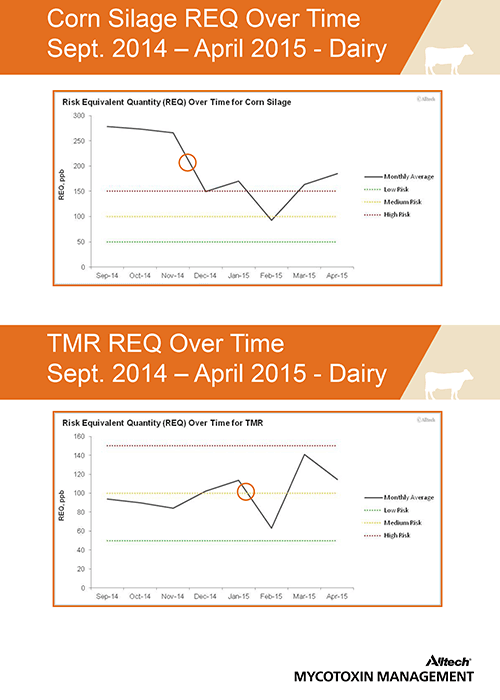
Dairy and beef producers should keep a watchful eye over the remaining 2014 crop in their bins as both corn silage and total mixed rations (TMR) are now trending at high risk for mycotoxin contamination, according to Alltech's recent storage analysis.
"Producers often ask how this is possible once the forage has been fermented. Mycotoxins are produced by soil-born molds and these not only infest the plant but are also brought into the storage facility with the harvested crop," said Dr. Max Hawkins, a nutritionist with Alltech's Mycotoxin Management Team. "Just as in the field, if the environmental factors are in place for the molds to flourish, they will; and if crops are stressed, they can produce a mycotoxin. Factors that affect mycotoxin production in fermented forages are plant stress prior to harvest, packing density, moisture, oxygen exposure and face management."
Through Alltech's Analytical Services Laboratory, the company's 37+® mycotoxin analysis program evaluates the change in mycotoxin numbers and levels over time from harvest throughout storage. By analyzing the number and levels of mycotoxins present, the program can provide a Risk Equivalent Quantity (REQ) of the increase in risk from harvest to feed out.
The REQ for harvest through December was reported at 244, a high risk for dairy cows. According to Hawkins, the main mycotoxins present during testing were Type B Trichothecenes and Fusaric Acid and together these can have a synergistic effect, impacting dry matter intake, milk production, gut health and immune response.
Through Alltech's recent storage analysis, the average 2015 sample has an REQ at 146, keeping the risk level at high alert. Type B Trichothecenes is still the main culprit; however the analysis showed less Fusaric Acid present than the earlier test.
"When looking at the timeline for the REQ for corn silage you can see a definite decrease from September through December but then a distinct increase from December to present," Hawkins said. "It appears that once the corn silage was opened up in the bins for feeding, REQ has steadily increased. This could be due to oxygen exposure and face management, but the REQ is over high risk and should be closely monitored moving forward."
The average TMR samples from September 2014 through April 2015 were at moderate risk but the trend since February 2015 has demonstrated a much higher REQ risk to cow health and performance. Beef TMR REQ has especially been trending higher in recent months.
Hawkins said both TMR and corn silage toxin trends are consistent with past analyses. Corn silage is at a particular high level alert, due to rising levels of Type B and A Trichothecenes and Fusaric Acid. These mycotoxins warrant monitoring as corn silage is exposed to more elements over time. TMR REQ is also expected to continue to rise, due in major part to corn silage inclusion.
"As I have been telling our customers, the only constant is change. During the spring and summer, stored fermented forages and high moisture grains are susceptible to dry matter and nutrient loss," Hawkins said. "These factors can contribute to decreased feed efficiency, performance and profitability."


 About Alltech:
About Alltech:Founded in 1980 by Dr. Pearse Lyons, Alltech improves the health and performance of people, animals, and plants hrough natural nutrition and scientific innovation. With more than 3,500 employees and a presence in 128 countries, the company has developed a strong regional presence in Europe, North America, Latin America, the Middle East, Africa and Asia. For further information, visit www.alltech.com. For media assets, visit www.alltech.com/press.
About 37+®:
Based at the Analytical Services Laboratory of Alltech in Winchester, Kentucky, and utilizing LC/MS/MS technology, Alltech's state of the art 37+® analytical method is the most advanced mycotoxin analysis available. The Analytical Services Laboratory of Alltech, Inc. was awarded ISO/IEC 17025:2005 accreditation, an international standard that recognizes the competence of testing laboratories.
5.8.2015